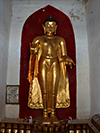|
Shwezigon Phaya (ရွှေစည်းခုံဘုရား)
Burmese.
‘Golden Dune
Pagoda’
or
‘Golden
Stupa
Pagoda’.
Name of a Buddhist temple near
Bagan,
of which construction began during the
reign of King
Anawrahta (fig.),
yet was only completed in 1102 AD, during
the reign of the latter's son
King
Kyansittha
(fig.).
The 49 meters high,
gold plated stupa reportedly enshrines
some relics of the
Buddha,
i.e. a tooth, a piece of the front skull, and a piece of collarbone, which were placed on the back of a sacred
White Elephant
(fig.),
which was then set free in order to determine a proper spot to built a stupa to
house them, akin to the establishment of
Wat Doi Suthep
in
Thailand's
Chiang Mai,
once a vassal to
Burma. The
White Elephant finally
stopped over a dune, which was consequently chosen as the site to erecting the
stupa, and which gave rise to its name. The
bell-shaped, gilded stupa is built atop the center of a large platform, with a
square base and consisting of three receding terraces, of which the sides at the
base are ca. 49 meters long and are guarded by large golden
chintha,
one at each of the corners, while each of the sides
of the platform has a central staircase guarded at the base by human-faced
lion-figures
that supports the
makara-shaped
(fig.)
balustrades leading to the top of the terraces. Akin to
Ananda Phaya (fig.),
the
terraces surrounding the
base of the stupa originally featured
550
glazed
terracotta
tiles of a dark greyish-green colour,
that portray scenes of the
jataka, though some are nowadays
missing. One tile depicts the Buddhist
Parable of the Snake, Elephant and Fox
(fig.).
At the eastern base of the
temple's main
stupa,
is a
small cavity in the ground which when filled with rain water reflects the image
of the stupa in the stagnant water, a phenomenon that brings many visitors to
their knees in order to see this charming attraction (map
-
fig.). Around the central and main
stupa there are several other shrines,
pyatthat
and edifices, including a small hall housing the 37 inner
nats (map
-
fig.), a
building topped with a
sikhara (fig.),
the Shwe Nyothin and Shwe Sagar
Shrine housing a father and son warrior nats (map
-
fig.), a
tazaung
with colourful
woodcarvings depicting folktales, the jataka and scenes from the life of the
Buddha (map
-
fig.), an open
edifice with wooden statues depicting the
Four Encounters
and the
Great Departure,
and
two shrines with a
reclining Buddha
inside a metal fence, one in the north (map
-
fig.) and a larger one in the south (map
-
fig.).
In 2016-2017, the main stupa has been renovated (fig.), with
goldbeaters applying fresh, hand-beaten (fig.)
gold plates (fig.).
This temple is
one of four temples
entwined in the Shwe Daw Lay Su legend of King Anawratha, which asserts that the
King was given some tooth relics of the
Buddha,
which were placed on the back of a
White Elephant to determine
an appropriate spot to built a pagoda to
house these relics. As legend has it, the White Elephant halted at four
different locations and the King later had stupas built at each of them (fig.),
resulting in the construction of three more pagodas, i.e.
Tantkyitaung Zedi
(fig.),
Lawkananda Zedi (fig.),
and
Tuyintaung Zedi (fig.). According to popular Burmese believe, if pilgrims to the relics
are able to visit all four of these holy places in a single morning, their
wishes will be fulfilled. There is also a statue of
a white
horse, which is caressed by
local worshippers
as they
pass it by
(map
-
fig.).
The horse is
assumed to represent either
Kanthaka,
i.e. the
snow-white horse of Prince
Siddharta,
which was born on the same day as its master and died of sorrow after it carried
the prince away from the palace during the
Great Departure,
or the white horse that ‒according to royal
chronicles‒ King Kyansittha, during whose reign this pagoda was completed, used
to ride while leading the procession at the dedication ceremony of newly
Buddhist temples. At the northern backside of the temple, outside its surrounding walls, is a
small shrine with a pond from which the tail of a
naga
protrudes (fig.)
and known in translation as the Stone Dragon Hall
(map).
It is the tail end
of a naga whose head emerges from a wall underneath the main
platform of the
Tantkyitaung Zedi (fig.),
a temple kilometers away and across the
Irrawaddy River (fig.).
Pilgrims to
either these places cleanse
themselves by pouring cups of water over this naga's head or tail, which they
scoop from the basin, just as many times as ones age,
plus one time.
See MAP.
回






|

